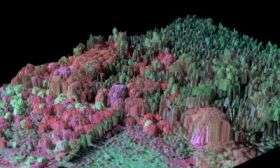3-D Imaging of invasive tree species (reds-pinks) and native Hawaiian lowland rainforest (greens). For more images go to http://cao.stanford.edu/cao_gallery.html. Credit: Gregory Asner
To the list of threats to tropical rainforests you can add a new one — trees. It might seem that for a rainforest the more trees the merrier, but a new study by scientists at the Carnegie Institution warns that non-native trees invading a rainforest can change its basic ecological structure — rendering it less hospitable to the myriad plant and animal species that depend on its resources. Results are published in the Proceedings of the National Academy of Sciences.
The research team, led by Gregory Asner of the Carnegie Institution’s Department of Global Ecology, used innovative remote sensing technology on aircraft to survey the impact of invasives on more than 220,000 hectares (850 square miles) of rainforest on the island of Hawaii.
Previous studies of the impact of invasive plants on forests were limited to small areas. Instruments aboard the Carnegie Airborne Observatory (CAO) penetrate the forest canopy to create a regional “CAT scan” of the ecosystem, identifying key plant species and mapping the forest’s three-dimensional structure.
“Invasive tree species often show biochemical, physiological, and structural properties that are different from native species,” says Asner. “We can use these ‘fingerprints’ combined with the 3-D images to see how the invasives are changing the forest.”
This is the first use of this approach to track invasives in Hawaii, where roughly half of all organisms are non-native, and approximately 120 plant species are considered highly invasive. Undisturbed Hawaiian rainforests are often dominated by the ohia tree (Metrosideros polymorpha), but these slow-growing native trees are losing ground to newcomers, such as the tropical ash (Fraxinus uhdei) and the Canary Island fire tree (Morella faya).
CAO surveys of rainforest tracts on the Mauna Kea and Kilauea Volcanoes found that stands of these two invasive tree species form significantly denser canopies than the native ohia trees. Less light reaches lower forest levels, and as a result native understory plants such as tree ferns are suppressed.
Introduced trees can also pave the way for more invaders by altering soil fertility. The Moluccan albizia (Falcataria moluccana) “fixes” atmospheric nitrogen, concentrating it in the soil, which speeds the growth of a smaller invasive tree, the Strawberry Guava (Psidium cattleianum). The guava trees form a dense, mid-level thicket that blocks most light from reaching the ground and stifles young native plants.
“All of our invasive species detections were made in protected state and federal rainforest reserves,” says Asner. “These species can spread across protected areas without the help of land use changes or other human activities, suggesting that traditional conservation approaches on the ground aren’t enough for the long-term survival of Hawaii’s rainforests.”
“These new airborne technologies, which are sensitive enough to discern saplings and young trees, may make the problem more tractable,”comments study co-author Flint Hughes of the US Forest Service. “They allow scientists to probe the make-up of forests over large areas and detect invasions at earlier stages.”
Based on the success of this study, Asner and colleagues plan to expand CAO surveys of the ecological impacts of invaders in other forests on Hawaii and Kauai Islands, where premier, remote rainforest reserves remain virtually unmapped.
Source: Carnegie Institution
























